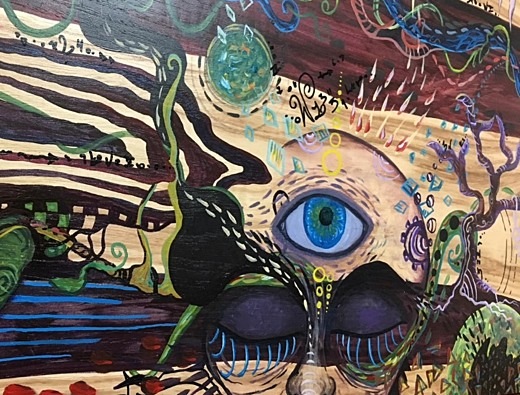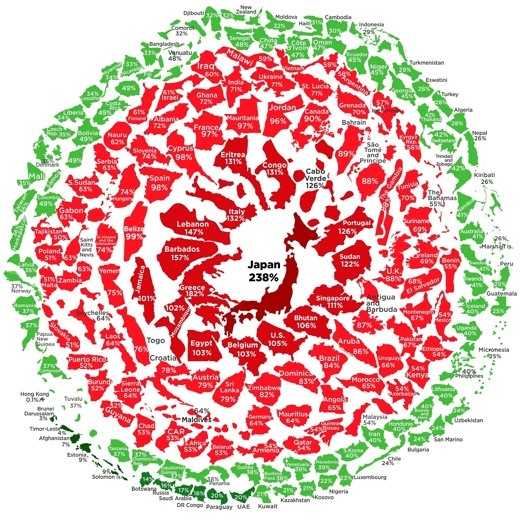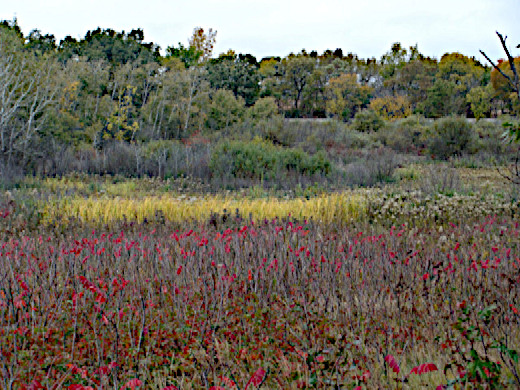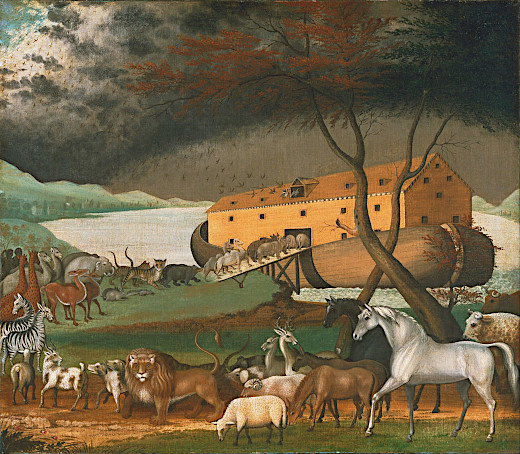SUBHEAD: Will puzzle artwork be the next crypto-currency trend to go mainstream?
By Tyler Durden on 30 December 2018 for Zero Hedge -
(https://www.zerohedge.com/news/2018-12-29/will-these-puzzles-be-next-crypto-trend-go-mainstream)

Image above: "Amir Taaki and Cody Wilson" portraits embedded in a crpto-puzzle painting solved in 2014 with a prize of 3.5 BTC (BitCoins). Click to enlarge. From original article and (https://bitcointalk.org/index.php?topic=661781.0). Note this "painting" is derived from a photo of the two founders of "Dark Wallet" - a system for hiding the identities of BitCoin owners. See (https://www.wired.com/2014/04/dark-wallet/).
The cryptocurrency mania that drove the price of a bitcoin to $20,000 last year has come and gone, leaving a legion of deeply disappointed marginal buyers in its wake. But anybody who still believes in the long-term promise of crypto - and is looking to pick up some coins on the cheap - should try their luck at a crypto puzzle.
What's a crypto puzzle? Put simply, it's a burgeoning genre of artwork where viewers race against one another to solve a puzzle embedded in the picture.
Whoever wins is rewarded with a purse of cryptocurrency.
Though the phenomenon first emerged in 2014, when @coin_artist, the pseudonym of Marguerite deCourcelle, created Dark Wallet Puzzle, the first known cryptopuzzle, Business Week claimed in a recent feature about the trend that cryptopuzzles are still thriving - with buyers even paying hefty sums for pieces even after they have been solved.
The Whitney Museum of American Art is planning to display its first crypto puzzle next spring. Until recently, most hidden-crypto-key artworks had been known only to nerdy collectors, their images circulated on websites such as Reddit and BitcoinTalk. Now they’re starting to enter the mainstream through galleries, museums, international exhibitions, and even video games. Many of the puzzles are also getting a bit easier to solve, giving more people a chance to crack the code and claim the coins. Some collectors are buying the art even after the puzzle has been solved and the digital currency extracted.

Image above: Detail of crypto artwork by Nanu Berk from an article about her thoughts on the new art industry. From (https://medium.com/blockchain-art-collective/crypto-art-is-no-easy-calling-heres-what-artist-nanu-berks-really-thinks-about-the-industry-7c5e84663614).
As the genre gains prominence in the mainstream art world, DeCourcelle is finding new ways to monetize the concept, including digital puzzles that resemble video games and selling pieces to collectors who are looking to own a piece of crypto history.
.
By Tyler Durden on 30 December 2018 for Zero Hedge -
(https://www.zerohedge.com/news/2018-12-29/will-these-puzzles-be-next-crypto-trend-go-mainstream)

Image above: "Amir Taaki and Cody Wilson" portraits embedded in a crpto-puzzle painting solved in 2014 with a prize of 3.5 BTC (BitCoins). Click to enlarge. From original article and (https://bitcointalk.org/index.php?topic=661781.0). Note this "painting" is derived from a photo of the two founders of "Dark Wallet" - a system for hiding the identities of BitCoin owners. See (https://www.wired.com/2014/04/dark-wallet/).
The cryptocurrency mania that drove the price of a bitcoin to $20,000 last year has come and gone, leaving a legion of deeply disappointed marginal buyers in its wake. But anybody who still believes in the long-term promise of crypto - and is looking to pick up some coins on the cheap - should try their luck at a crypto puzzle.
What's a crypto puzzle? Put simply, it's a burgeoning genre of artwork where viewers race against one another to solve a puzzle embedded in the picture.
Whoever wins is rewarded with a purse of cryptocurrency.
Though the phenomenon first emerged in 2014, when @coin_artist, the pseudonym of Marguerite deCourcelle, created Dark Wallet Puzzle, the first known cryptopuzzle, Business Week claimed in a recent feature about the trend that cryptopuzzles are still thriving - with buyers even paying hefty sums for pieces even after they have been solved.
Marguerite deCourcelle lives at the peculiar intersection of Bitcoin and art. Under the pseudonym @coin_artist, she’s credited with inventing the crypto-art puzzle, a genre of images hiding complicated ciphers that reward the first solver with a walletful of virtual currency.
he most famous of these is an @coin_artist oil pastel from 2015 called Torched H34R7S, the final work in a series known as The Legend of Satoshi Nakamoto. Depicting a turtledove, chess pieces, and a phoenix surrounded by flames, the painting incorporates symbolic references to Bitcoin’s creator, as well as to Shakespeare and deCourcelle’s personal life.
An anonymous person solved the riddle in 2018, unlocking 5 Bitcoins, at the time worth about $50,000.
DeCourcelle started the Bitcoin-art-puzzle phenomenon in 2014 with Dark Wallet Puzzle, a painting of two leading crypto anarchists that hides a key. It led to a 3.4-Bitcoin reward. "I created it after realizing that without a third party litigating how money moves, that money could be ‘pulled out’ of anything," she says.The result is a strange amalgam of the crypto and art-world universes, as crypto puzzles are beginning to "enter the mainstream through galleries, museums, international exhibitions, and even video games." In a way, winning crypto purses from solving these visual puzzles isn't that much different than the process of crypto mining - the only difference is that humans are solving the puzzles and not computers.
The Whitney Museum of American Art is planning to display its first crypto puzzle next spring. Until recently, most hidden-crypto-key artworks had been known only to nerdy collectors, their images circulated on websites such as Reddit and BitcoinTalk. Now they’re starting to enter the mainstream through galleries, museums, international exhibitions, and even video games. Many of the puzzles are also getting a bit easier to solve, giving more people a chance to crack the code and claim the coins. Some collectors are buying the art even after the puzzle has been solved and the digital currency extracted.
This spring artist Andy Bauch showcased “New Money,” a collection of mosaics, at the Castelli Art Space in Los Angeles. The patterns in the pieces, which were made of thousands of Lego blocks and included a 4-by-9-foot horizontal triptych, contained clues to troves of Bitcoin and other cryptocurrencies. "How seemingly arbitrary art prices are, and seeing crypto prices fluctuating wildly, I was curious,” Bauch says. "Will the cryptocurrency I put in this art appreciate? Will the art itself appreciate regardless of the cryptocurrency?"
Three of his works have sold - one of them for $14,000 - though the virtual coins hidden within one had already been taken before the show began. Per the unspoken rules of the crypto-art crowd, Bauch had posted photos of the works online, where anyone could view them and try to decipher their riddles.
The pieces are also getting some high-profile attention from the art world. The Whitney Museum of American Art in New York plans to show a 16-millimeter film by Jennifer and Kevin McCoy that offers clues to a Bitcoin address.
The first solver will be named as one of the official donors of the piece, a distinction that can be resold or traded. At Bitcoin Art (r)evolution in Paris this fall, some 1,000 visitors in the course of a week viewed 40 works from @coin_artist and others, organizer Pascal Boyart says. He plans to embed crypto-art puzzles in his murals in the city’s streets.

Image above: Detail of crypto artwork by Nanu Berk from an article about her thoughts on the new art industry. From (https://medium.com/blockchain-art-collective/crypto-art-is-no-easy-calling-heres-what-artist-nanu-berks-really-thinks-about-the-industry-7c5e84663614).
As the genre gains prominence in the mainstream art world, DeCourcelle is finding new ways to monetize the concept, including digital puzzles that resemble video games and selling pieces to collectors who are looking to own a piece of crypto history.
DeCourcelle, who has an art degree from Eastern Oregon University, made the final piece of The Legend of Satoshi Nakamoto series when she found herself suddenly single and parenting two small children, living in a rented room at a friend’s house with no steady means of support.
She spent four months working at night, during her boys’ naptimes, and between freelance projects to finish the painting, for which she’d already pledged 3.5 of her own Bitcoins in prize money.
She survived in the meantime by selling the original Dark Wallet Puzzle painting for 10 Bitcoins, or about $3,000 at the time.
"I just wanted a piece of that history," says buyer Brooke Royse-Mallers, a Bitcoin investor and avid crypto-puzzle-solver. "The history of Bitcoin’s evolution and my evolution with it, I guess. That painting helped me learn more about the technology without being a coder."Though most crypto puzzles aren't worth much, DeCourcelle says she's been offered as much as $1 million for her work over the years. That should give remaining crypto entrepreneurs hope: If they're dissatisfied with the retail price, they can try packaging it with a visual puzzle to boost the price.
.









